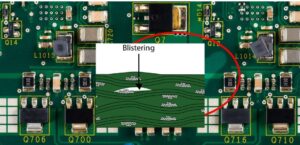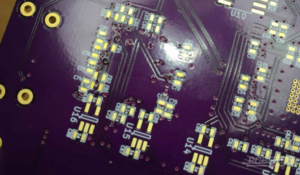Board surface blistering is one of the more common quality defects in the production process of circuit boards, because the complexity of the production process of circuit boards and the complexity of process maintenance, especially in the chemical wet treatment, making the prevention of board surface blistering defects more difficult. The author based on years of practical production experience and service experience, is now the causes of the circuit board sink copper plating plate blistering to do a brief analysis, I hope to help industry peers!
The circuit board surface blistering is actually the problem of poor board bonding, and by extension, the surface quality of the board, which contains two aspects: 1. the problem of board cleanliness; 2. the problem of surface microscopic roughness (or surface energy); all the board blistering problems on the circuit board can be summarized as the above causes. Poor or too low bonding between the plating, in the subsequent production process and assembly process is difficult to resist the production process generated during the plating stress, mechanical stress and thermal stress, etc., eventually resulting in different degrees of separation between the plating phenomenon.
Some of the factors that may cause poor board quality during production and processing are summarized below:
- The problem of substrate processing; especially for some thin substrates, (generally below 0.8mm), because the substrate is less rigid, it is not suitable to brush the board with a brush machine, which may not be effective in removing the substrate production process to prevent the board surface copper foil oxidation and special treatment of the protective layer, although the layer is thin, brush the board is easier to remove, but the use of chemical treatment there are greater difficulties So in the production and processing of important attention to control, so as not to cause the board surface of the substrate copper foil and chemical copper between the poor bonding force caused by the board blistering problem; this problem in the thin inner layer for blackening, there will also be poor blackening browning, uneven color, local black browning not on the problem.
- Board surface in the process of machining (drilling, laminating, milling edge, etc.) caused by oil or other liquid staining dust pollution surface treatment poor phenomenon.
- Sink copper brush plate bad: sink copper before grinding plate pressure is too large, resulting in deformation of the orifice brush out the orifice copper foil rounded or even orifice leakage base material, so that in the process of sink copper plating spray tin welding and other processes will cause the orifice blistering phenomenon; even if the brush plate does not cause leakage base material, but too heavy brush plate will increase the roughness of the orifice copper, and therefore in the micro-etching roughening process Even if the brush plate does not cause leakage of the substrate, but too heavy a brush plate will increase the roughness of the copper at the orifice, so that the copper foil is easy to produce excessive roughing in the process, there will also be a certain quality risk; therefore, attention should be paid to strengthening the control of the brush plate process, and the parameters of the brush plate process can be adjusted to the best through the abrasion mark test and water film test.
- Water washing problem: Because the sink copper plating treatment to go through a large number of chemical potion treatment, all kinds of acid and alkali induction organic and other pharmaceutical solvents are more, the board surface water washing is not clean, especially the sink copper adjustment degreasing agent, will not only cause cross-contamination, but also cause the board surface local poor treatment or treatment effect is not good, uneven defects, resulting in Some bonding problems; Therefore, we should pay attention to strengthen the control of water washing, mainly including the control of cleaning water flow, water quality, washing time, and board drip time, etc.; Especially in winter, the temperature is low, the effect of water washing will be greatly reduced, more attention will be strong on the control of water washing.
- The micro-etching in the pretreatment of sink copper and graphics plating pretreatment; excessive micro-etching will cause the hole to leak the substrate, resulting in blistering around the hole; insufficient micro-etching will also cause the bonding force to be insufficient, resulting in blistering; therefore, to strengthen the control of micro-etching; general micro-etching depth in the pretreatment of sink copper in 1.5 — 2 microns, graphics Plating pre-treatment micro-etching in 0.3 – 1 micron, the best conditions through chemical analysis and simple test weighing method to control the thickness of micro-etching or for the etching rate; in general, the plate surface after micro-etching bright color, uniform pink, no reflection; if the color is not uniform, or there is a reflection indicates that the quality of the pre-processing hidden problems; pay attention to strengthen the inspection; in addition, the micro-etching tank copper content, tank temperature, loading, In addition, the copper content of the microetching tank, the tank temperature, the loading, the microetching agent content, etc. are all items to be noted.
- The copper sink is too active; the copper sink is newly opened or the three major components in the tank are too high, especially the copper content is too high, which will cause the tank to be too active, the chemical copper deposition is rough, hydrogen, copper oxide, etc. in the chemical copper layer is too much intermingled with the physical quality of the coating and poor bonding defects; the following methods can be adopted: reduce the copper content, (add pure water to the tank) including the three major components. Pure water) including the three major components, appropriate to improve the complexing agent and stabilizer content, appropriate to reduce the temperature of the bath, etc. The oxidation of the plate surface occurs during the production process; if the sinker plate is oxidized in the air, it may not only cause no copper in the hole, the plate surface is rough, but also may cause the plate surface to blister; if the sinker plate is stored in the acid solution for too long, the plate surface will also be oxidized, and this oxidation film is difficult to remove; therefore, the sinker plate in the production process should be timely Thickening treatment, should not be stored for too long, generally within 12 hours at the latest to thicken copper plating finished.
- Sink copper rework bad; some sink copper or graphics after the rework board in the rework process because of poor fading, rework method is not correct or rework process micro-etching time control is not appropriate or other reasons will cause the board surface blistering; sink copper board rework if found on the line sink copper bad can be found by water washing directly from the line after oil removal acid cleaning Directly reworked without etching; best not to re-oil, micro-etching; for the board has been thickened plate electricity, should now micro-etching tank fade plating, pay attention to time control, you can first use one or two pieces of board roughly measured fade plating time, to ensure the fade plating effect; fade plating is completed after the application of brush board machine after a group of soft abrasive brush light brush and then sink copper according to the normal production process, but etching micro-etching time to be halved or make the necessary adjustments.
- Insufficient washing after developing in the graphics transfer process, too long after developing or too much dust in the workshop can cause poor board cleanliness and slightly poor fiber treatment, which may cause potential quality problems.
- The acid bath should be replaced in time before copper plating. Too much contamination in the bath, or too high copper content, will not only cause problems with board cleanliness, but also defects such as roughness on the board surface.
- Organic contamination in the plating bath, especially oil contamination, is more likely to occur for automatic lines.
12. In addition, some plants in winter production in the tank without heating, more special attention to the production process plate charged into the tank, especially with air agitation tank, such as copper-nickel; for nickel cylinder winter best to add a heated water wash tank before nickel plating, (water temperature at about 30-40 degrees), to ensure that the initial deposition of nickel layer dense and good.

In the actual production process, caused by the plate blistering many reasons, I can only do a brief analysis, for different manufacturers of equipment technology level may be different reasons for the blistering phenomenon, the specific situation to specific analysis, not a generalization, rigid; the above reasons for the analysis is not divided into priority and importance, basically in accordance with the production process to do a brief The above analysis of the causes, regardless of priority and importance, basically in accordance with the production process to do a brief analysis, in this series out, just to give you a direction to solve the problem and a more open vision, I hope that the process of production and problem solving for everyone, can play a brick to lead the role of jade!














